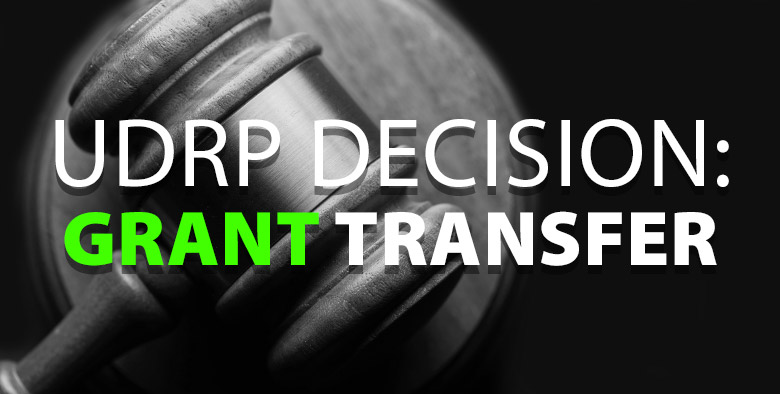There are fewer than 40 UDRP cases involving .Click domain names since 2015. The latest one involves the domain ARM.click and while “arm” is a dictionary word, it’s also a trademark of a well-known technology company that operates from ARM.com.
The domain’s China-based registrant placed it for sale at DAN with an asking price of $5,000 dollars.
The WIPO panelist latched onto that, stating:
Given the fact that the Respondent registered or acquired the disputed domain name in September 2020 and is offering the disputed domain name for sale for USD 5,000, it is clear that the Respondent registered the disputed domain name in bad faith for the purpose of selling, renting, or transferring the domain name to the Complainant or the Complainant’s competitors.
Final decision: Transfer ARM.click to the Complainant.

Copyright © 2025 DomainGang.com · All Rights Reserved.WIPO Arbitration and Mediation Center
ADMINISTRATIVE PANEL DECISION
Arm Limited v. Super Privacy Service LTD c/o Dynadot / Ya Lin
Case No. D2021-09691. The Parties
The Complainant is Arm Limited, United Kingdom, represented by Quinn IP Law, United States of America (“United States”).
The Respondent is Super Privacy Service LTD c/o Dynadot, United States / Ya Lin, China.
2. The Domain Name and Registrar
The disputed domain name <arm.click> is registered with Dynadot, LLC (the “Registrar”).
3. Procedural History
The Complaint was filed with the WIPO Arbitration and Mediation Center (the “Center”) on March 31, 2021. On March 31, 2021, the Center transmitted by email to the Registrar a request for registrar verification in connection with the disputed domain name. On April 1, 2021, the Registrar transmitted by email to the Center its verification response disclosing registrant and contact information for the disputed domain name which differed from the named Respondent and contact information in the Complaint. The Center sent an email communication to the Complainant on April 1, 2021, providing the registrant and contact information disclosed by the Registrar, and inviting the Complainant to submit an amendment to the Complaint. The Complainant filed an amendment to the Complaint on April 6, 2021.
The Center verified that the Complaint, together with the amendment to the Complaint, satisfied the formal requirements of the Uniform Domain Name Dispute Resolution Policy (the “Policy” or “UDRP”), the Rules for Uniform Domain Name Dispute Resolution Policy (the “Rules”), and the WIPO Supplemental Rules for Uniform Domain Name Dispute Resolution Policy (the “Supplemental Rules”).
In accordance with the Rules, paragraphs 2 and 4, the Center formally notified the Respondent of the Complaint, and the proceedings commenced on April 7, 2021. In accordance with the Rules, paragraph 5, the due date for Response was April 27, 2021. The Respondent did not submit any response. Accordingly, the Center notified the Respondent’s default on April 28, 2021. The Center received an unsolicited supplemental filing from the Complainant on May 2, 2021.
The Center appointed John Swinson as the sole panelist in this matter on May 4, 2021. The Panel finds that it was properly constituted. The Panel has submitted the Statement of Acceptance and Declaration of Impartiality and Independence, as required by the Center to ensure compliance with the Rules, paragraph 7.
4. Factual Background
The Complainant has been providing technology related goods and services since 1990, including parts for mobile phones such as computer processors, graphic processors, and digital memories.
The Complainant owns a large portfolio of trademark registrations for the trademark ARM in a number of different jurisdictions, including a United States trademark registration that was filed on May 24, 1999, for ARM and registered on March 21, 2000 (U.S. Reg. No. 2,332,930). The Complainant also owns over 190 domain names that begin with the ARM trademark. The Complainant’s primary website is located at “www.arm.com”.
The Respondent did not file a Response, so little is known about the Respondent.
The disputed domain name was registered on September 25, 2020.
At the date of this decision, the disputed domain name resolves to the “www.dan.com” website where it is listed for sale for a price of USD 5,000.
5. Parties’ Contentions
A. Complainant
The Complainant made the following submissions in the Complainant:
Identical or Confusingly SimilarThe disputed domain name is legally identical and confusingly similar to trademarks in which the Complainant has established legal rights. The disputed domain name is likely to cause confusion amongst the public and in the marketplace and to cause the public to be mistaken, misled, and deceived as to the source of the disputed domain name.
The Complainant’s ARM trademarks enjoy a long history of use and enormous marketplace recognition and goodwill.
The Complainant has been providing technology related goods and services since 1990 and has had numerous decades-long registrations for its ARM mark. The Complainant designs sophisticated electronic products, including computer processors, graphics processors, digital memories and peripheral hardware and supplies software, development tools for computer hardware, and provides software and consultancy services.
The Complainant has sold over 180 billion products under its ARM brand, and its products and services reach over 70 percent of the world’s population. The Complainant’s processors are used as the main Central Processing Unit for most mobile telephones, in addition to providing the CPUs for many other, widely used, devices including laptops, tablets, televisions, and other electronic products.
The Complainant owns over 120 ARM and ARM formative trademark registrations worldwide.
The Complainant’s ARM trademark is recognized as a “well-known” mark as defined under the Paris Convention. This legal recognition was granted in a series of court and administrative decisions in answer to challenges by third parties against the strength of the ARM trademark.
The disputed domain name incorporates the Complainant’s ARM trademark in its entirety. This is sufficient to establish confusing similarity.
Rights or Legitimate InterestsThe Respondent is not commonly known as “ARM.”
The disputed domain name contains a single webpage soliciting offers for purchase of the disputed domain name.
The Respondent is not affiliated with or licensed by the Complainant. The Respondent does not have any trademark registrations for the trademark ARM or the disputed domain name.
Prior to the initiation of this proceeding, the Respondent had not used the disputed domain name in connection with a bona fide offering of goods and/or services.
The Respondent never responded to the Complainant’s demand letter. Such action by the Respondent, is further evidence of the Respondent’s lack of any legitimate interest in the disputed domain name.
Registered and Used in Bad FaithThe Respondent is not commonly known by the disputed domain name and has no legitimate reason to have registered a domain incorporating in full the Complainant’s ARM trademark except to attempt to capitalize on the enormous goodwill and marketplace recognition associated with the Complainant’s trademarks and to prevent the Complainant from being able to register the domain name itself.
The Complainant’s ARM mark is distinctive and famous, having been in use since at least as early as 1990.
Given the fame and distinctiveness of the Complainant’s mark, the Respondent has no legitimate reason to have registered a domain name which incorporates the Complainant’s ARM mark except for the purpose of preventing the Complainant from registering the domain or attempting to profit from the Complainant’s intellectual property rights in its ARM trademark.Given the distinctiveness, fame, and long history of use of the Complainant’s trademarks, the public is likely to be confused, misled, and deceived as to the source of the disputed domain name and are likely to be misdirected away from the Complainant when, in fact, the public is actually searching for the Complainant.
The disputed domain name does not present any website content and appears to be an inactive domain. The disputed domain name is not being used. This passive holding of the disputed domain name constitutes bad faith, taking into consideration the overall context of the Respondent’s behaviour.
Given the fact that the Respondent registered or acquired the disputed domain name in September 2020 and is offering the disputed domain name for sale for USD 5,000, it is clear that the Respondent registered the disputed domain name in bad faith for the purpose of selling, renting, or transferring the domain name to the Complainant or the Complainant’s competitors.
Further, the Respondent’s bad faith is evidenced by the Respondent’s failure to respond to the Complainant’s demand letter and passive holding of the disputed domain name after receipt of the Complainant’s demand letter.
B. Respondent
The Respondent did not reply to the Complainant’s contentions.
6. Discussion and Findings
To succeed, the Complainant must demonstrate that all of the elements enumerated in paragraph 4(a) of the Policy have been satisfied, namely:
(i) the disputed domain name is identical or confusingly similar to a trademark or service mark in which the Complainant has rights; and
(ii) the Respondent has no rights or legitimate interests in respect of the disputed domain name; and
(iii) the disputed domain name has been registered and is being used in bad faith.The onus of proving these elements is on the Complainant even though the Respondent failed to submit a Response.
Paragraph 15(a) of the Rules directs the Panel to decide the complaint on the basis of the statements and documents submitted and in accordance with the Policy, these Rules and any rules and principles of law that it deems applicable.
The Complainant submitted an unsolicited supplemental filing on May 2, 2021. This filing included at copy of a recent decision that was published after the original complaint was filed. That decision is Arm Limited v. Privacy Administrator, Anonymize, Inc. / Sarbel Bandak, WIPO Case No. D2021-0594. The panel considered this decision but not the written submissions regarding this decision that were included in the supplemental filing.
A. Identical or Confusingly Similar
The Complainant has clearly proven ownership of numerous registered trademarks for ARM in the United States and a number of other jurisdictions.
The disputed domain name is identical to that trademark, disregarding the Top-Level Domain “.click”.
The Complainant succeeds on the first element of the Policy in relation to the disputed domain name.
B. Rights or Legitimate Interests
The second requirement the Complainant must prove is that the Respondent has no rights or legitimate interests in the disputed domain name.
Paragraph 4(c) of the Policy provides that the following circumstances can be situations in which the Respondent has rights or legitimate interests in a disputed domain name:
(i) before any notice to [the Respondent] of the dispute, [the Respondent’s] use of, or demonstrable preparations to use, the [disputed] domain name or a name corresponding to the [disputed] domain name in connection with a bona fide offering of goods or services; or
(ii) [the Respondent] (as an individual, business, or other organization) has been commonly known by the [disputed] domain name, even if [the Respondent] has acquired no trademark or service mark rights; or
(iii) [the Respondent] is making a legitimate noncommercial or fair use of the [disputed] domain name, without intent for commercial gain to misleadingly divert consumers or to tarnish the trademark or service mark at issue.These are illustrative only and are not an exhaustive listing of the situations in which a respondent can show rights or legitimate interests in a domain name.
The onus of proving this requirement, like each element, falls on the Complainant.
Panels have recognized the difficulties inherent in proving a negative, however, especially in circumstances where much of the relevant information is in, or likely to be in, the possession of the respondent.
Accordingly, it is sufficient for a complainant to raise a prima facie case against the respondent under this head and an evidential burden will shift to the respondent to rebut that prima facie case.
There is no evidence that the Respondent is commonly known by the disputed domain name or has a trademark registration for ARM or similar.
The Complainant states that the Respondent is not affiliated with or licensed by the Complainant.
There is no evidence that the Respondent is making any use of the disputed domain name, other than on a website where the disputed domain name is listed for sale.
In these circumstances, the Complainant has established a clear prima facie case that the Respondent has no rights or legitimate interests in the disputed domain name. The Respondent has not sought to rebut that prima facie case. Accordingly, the Panel finds that the Complainant succeeds on the second element of the Policy in relation to the disputed domain name.
C. Registered and Used in Bad Faith
Paragraph 4(a)(iii) of the Policy provides that the Complainant must establish that the Respondent registered and subsequently used the disputed domain name in bad faith.
Paragraph 4(b)(i) states that the following shall be evidence of the registration and use of a domain name in bad faith:
“circumstances indicating that you have registered or you have acquired the domain name primarily for the purpose of selling, renting, or otherwise transferring the domain name registration to the complainant who is the owner of the trademark or service mark or to a competitor of that complainant, for valuable consideration in excess of your documented out-of-pocket costs directly related to the domain name.”
At the date of this decision, the disputed domain name resolves to the “www.dan.com” website where it is listed for sale for a price of USD 5,000.
The Respondent did not respond to the Complainant’s demand letter.
The Complainant has presented evidence that the Complainant’s ARM trademark is well known. The disputed domain name is identical to the Complainant’s trademark (disregarding the Top-Level Domain “.click”.)
In these circumstances, where the disputed domain name was registered in September 2020 and then listed for sale less than six months later for a substantial price, the Panel concludes that the disputed domain name was registered primarily for the purpose of selling the disputed domain name for an amount presumably in excess of the Respondent’s out-of-pocket costs. In light of the reputation of the Complainant’s trademark, it is reasonable to conclude that the Respondent registered the disputed domain name to sell to the Complainant or a competitor of the Complainant.
Accordingly, the Panel finds that the Complainant meets the requirements of paragraph 4(b)(i) of the Policy.
The Complainant succeeds on the third element of the Policy in relation to the disputed domain name.
7. Decision
For the foregoing reasons, in accordance with paragraphs 4(i) of the Policy and 15 of the Rules, the Panel orders that the disputed domain name <arm.click> be transferred to the Complainant.
John Swinson
Sole Panelist
Date: May 11, 2021












